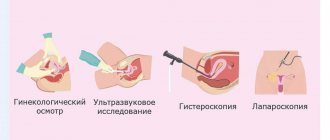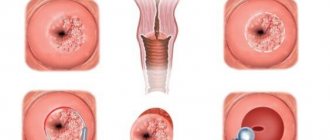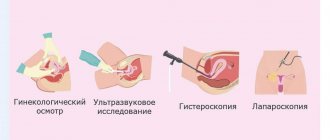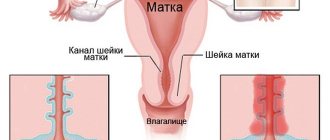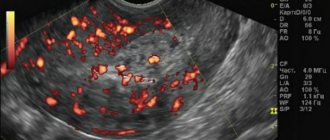Today this method is actively used in medicine. Its essence lies in making several small incisions on the body through which instruments are inserted to perform the necessary actions. Visualization occurs on the monitor. The picture appears due to the introduction of a small probe with a video camera into the abdominal cavity. Thanks to this, the patient loses a small amount of blood and avoids incisions and scars.
Fallopian tube laparoscopy
Doctors recommend surgery using this method in the following cases:
- uterine fibroids;
- abnormalities in the development of the uterus;
- endometriosis;
- pelvic organ prolapse;
- development of a cancerous tumor at an early stage;
- chronic pelvic pain.
This operation is also used to clarify the diagnosis in order to understand the cause of female infertility.
Laparoscopy of ovarian cysts is used quite often to remove tumors. This method of surgical intervention is also used:
- with ectopic pregnancy;
- the presence of adhesions in the pelvic area;
- inflammatory processes in the pelvic organs;
- hydrosalpinx;
- purulent tubovarial formations;
- pathology of the fallopian tubes.
Only a doctor can determine the need for surgery, depending on the stage of development of the pathology and the patient’s health condition.
Benefits of laparoscopy
The main advantages of the method include:
- Anesthetic risk - in modern clinics, such a risk is unlikely. A good anesthesiologist will always find out during the consultation possible complications from anesthesia and choose the most optimal drug for you;
- Risk associated with initial needle insertion. Since the needle is inserted blindly, damage is possible. According to medical statistics, such injuries occur in 0.1–0.4% of patients; Carrying out simultaneous diagnosis and treatment;
- Short period of hospital stay (about two to three days);
- Short recovery period;
- after the operation there are no scars and no pain;
- negligible risk of adhesions.
Laparoscopy is an effective and fairly safe surgical intervention, provided that it is performed by a doctor with extensive experience and high professionalism. Also, do not forget about the qualifications of other medical personnel and the high degree of equipment of the clinic with new modern equipment. Only with a combination of all these factors will laparoscopy bring the desired result and will not affect your health in any way.
You can find out about the prices for laparoscopy in Novosibirsk below in the “Cost of services” section.
Types of laparoscopy and indications for it
There are the following types of laparoscopic surgery:
- Diagnostic (carried out to establish or confirm a diagnosis; treatment can be carried out simultaneously with the study).
- Surgical (carried out after all tests have been completed if there are no results from conservative treatment).
- Control (carried out to monitor previously performed surgical treatment).
Indications for laparoscopy are:
- Suspicion of infertility;
- diagnosing appendicitis, cholecystitis;
- tumors of the abdominal cavity and pelvis;
- ectopic pregnancy;
- cystic formations on the ovaries;
- uterine fibroids;
- endometriosis.
Despite the effectiveness and safety of the method, there are some contraindications for the procedure:
- cardiovascular diseases;
- blood clotting disorder;
- severe pulmonary diseases;
- acute stage of infectious diseases;
- late stages of pregnancy;
- large accumulation of blood in the peritoneum.
Due to the possible risks of complications in the presence of these pathologies, alternative treatment methods are used.
The following laparoscopic operations are performed at the Academy of Health Medical Center:
Laparoscopic removal of endometrioid cyst
Laparoscopic cystectomy - removal of an ovarian cyst.
Diagnostic laparoscopy
Laparoscopic sterilization - transection of the fallopian tubes, cauterization of the fallopian tubes, ligation of the fallopian tubes.
Laparoscopic salpingectomy - tubectomy, removal of fallopian tubes.
Laparoscopic salpingostomy - restoration of patency of the fallopian tubes, used in the treatment of infertility.
Laparoscopic chromosalpingoscopy - diagnostics of fallopian tube patency, used in the treatment of infertility.
Laparoscopic ovarian cauterization - drilling of the ovaries, making incisions on the ovaries, is used in the treatment of infertility.
Laparoscopic removal of myomatous (fibromatous) nodes - myomectomy, treatment of uterine fibroids.
Thick-needle biopsy of fibromatous nodes.
Laparoscopic oophorectomy - removal of the ovary.
Laparoscopic adnexectomy - removal of the uterine appendages.
Laparoscopy for external endometriosis - cauterization of endometriosis foci.
All operations are performed by experienced surgeons using modern equipment. Surgical treatment is carried out only after consultation with specialists from the Academy of Health medical center.
Features of diagnosis and therapy
An appointment with a gynecologist begins with an examination of the external and internal genital organs using mirrors, and palpation to identify tumors. Regular diagnostics includes taking laboratory smears for flora and atypical cells. Smears are taken from the vagina, the surface of the cervix and urethra. They allow you to assess the ratio of beneficial and pathogenic bacteria in the genitals, identify dysbacteriosis and other disorders.
An important component of diagnosis is ultrasound examination of the pelvic organs, which can be transvaginal or abdominal. The first method, in which the sensor is inserted into the vagina, is more preferable due to its accuracy. Ultrasound allows not only to study the structure of internal organs, their size, location, but also to exclude the presence of neoplasms.
If formations are detected on the cervix, the doctor recommends undergoing colposcopy, in which this organ is examined under high magnification using special equipment. Additionally, a specialist can give directions for blood and urine tests to identify inflammatory processes.
Treatment depends on the characteristics of the pathology. The specialist prescribes a course of antibacterial or antifungal drugs in the form of tablets or vaginal suppositories; In case of illness, antibiotics may be prescribed in the form of injections. To restore the menstrual cycle and eliminate benign neoplasms in the form of cysts, hormonal drugs are often prescribed.
Reception of a specialist of this profile in our medical center is carried out by appointment on the website or by telephone. The price for gynecologist services is indicated in the price list; You can clarify the cost of procedures and diagnostics during a personal conversation with the center administrator.
How does it go?
At its core, for the patient, laparoscopy is not much different from conventional surgery.
The patient is put under anesthesia, the surgeon cleans the skin and makes several small incisions into which metal tubes are inserted, which will provide access to the internal organs. Usually there are three such holes - two for tools and one for the camera. Afterwards, the cavity is pumped with gas or air, which provides free access to any organ.
To perform the operation, the surgeon has the entire necessary set of laparoscopic instruments - scalpels, scissors, needles for suturing wounds, coagulation, etc. This allows you to carry out any manipulation.
After the manipulation, the wounds are sutured, if necessary, leaving drainage to drain the ichor from the cavities, and the patient is taken out of anesthesia. The rehabilitation period after this operation is much shorter than after abdominal surgery - about 1-2 weeks.
Laparoscopy and hysteroscopy are two minimally invasive methods used in gynecology
Laparoscopy is used to perform operations on the uterus and appendages (tubes, ovaries). Easy access to these organs is through the abdominal cavity.
The gynecologist makes 3 punctures, with a diameter from 3 mm to 10 mm. A microcamera is inserted into the hole, which displays the image on the monitor and magnifies it several times. The doctor inserts instruments for manipulation into other holes. The intervention takes place under general anesthesia - a mask with the drug “Sevoran”. After such a gynecological operation, the patient recovers quickly and can go home within 24 hours.
Using hysteroscopy, the doctor performs diagnostics or surgery in the uterine cavity or cervix. Convenient access to these organs is through the vagina.
The gynecologist inserts a thin tube with a camera, the image is transmitted to the monitor and enlarged. The doctor examines the organs and may take a piece of tissue for analysis or remove a polyp. The anesthesiologist uses general anesthesia - Propofol intravenously. 2-3 hours after the procedure, the patient can go home.
Sometimes hysteroscopy and laparoscopy are performed simultaneously. Most often - for infertility, for example, to correctly identify pathology and make a diagnosis. This is convenient for the patient: one preparation for surgery, one anesthesia, but two procedures.
Clinical manifestation
Based on the severity, there are 4 degrees of displacement of the uterus and vagina: prolapse, as well as partial, incomplete and complete prolapse.
The pathology is manifested by the following symptoms:
- sensation of a foreign body in the perineum that interferes with walking;
- exit from the genital slit of the vaginal walls, cervix or the entire uterus;
- feeling of heaviness, pain in the sacral area;
- discomfort and pain during sexual intercourse;
- when combined with a displacement of the bladder - difficult, painful urination, uncontrolled leakage of urine when coughing, sneezing, or physical stress;
- with concomitant rectal prolapse - foreign body sensation, pain and difficulty defecating;
- drying of the vaginal mucosa, inflammation of the cervix;
- the formation of ulcers and inflammation on the prolapsed mucosa due to its chronic injury;
- menstrual irregularities, painful menstruation.

Using minimally invasive gynecological surgeries, doctors
- return reproductive function
Laparoscopic surgeries help with infertility. Surgeons restore the patency of the tubes, remove endometriomas - ovarian cysts, foci of endometriosis in the abdominal cavity. Adhesions are dissected and preparations are made for IVF.
- preserve organs
Before the advent of laparoscopy in gynecology, it was impossible, for example, to preserve the fallopian tubes or restore their functions.
During the procedure, the surgeon operates microscopic instruments - this is a delicate work. Such an operation cannot be done by hand, so the impact on the body is minimal, which means rehabilitation is easier.
- easily remove tumors
Using laparoscopy, gynecological surgeons remove cystomas - ovarian tumors, fibroids - tumors in the uterus, and tissue affected by endometriosis.
Surgeons at the Pasman Clinic cope with oncological formations at the first stage.
- restore the possibility of sexual activity
After childbirth, women often experience relaxed (relaxed) vaginal syndrome or prolapse (prolapse, prolapse) of the genital organs. Sensitivity decreases, the level of pleasure from intimacy decreases, and discomfort appears.
The reason is that the pelvic floor muscles have stretched but have not returned to their original state. Plastic surgery - thread lifting - will help. The surgeon inserts threads into the vaginal tissue and restores its shape. In 18 months, a natural frame is formed that supports the muscles.
Postponing surgery is dangerous
“You can’t put it off, because any neoplasm in the abdomen and pelvis can lead to cancer. The sooner you operate, the less chance that something bad will grow,” explained gynecologist surgeon Tatyana Vladimirovna Veretelnikova
Olga suffered severe pain during her period and thought that this was normal.
Doctors found the cause and restored the joy of life
Olga, 25 years old. The patient had a little stomach pain, but she didn’t pay attention. During menstruation, the pain intensified, but my mother said that this was normal and should be endured. The girl took antispasmodic tablets, but they didn’t really help.
Soon Olga met a young man, but sex life turned out to be impossible. The girl experienced severe pain.
The patient consulted a gynecologist. An ultrasound specialist did an examination and saw an endometriotic ovarian cyst measuring 12–15 cm, and there was a liter of fluid in it. A huge tumor occupied the entire small pelvis. Tumor markers were elevated. Olga was immediately sent for surgery to remove a cyst at the third stage of endometriosis. It was difficult, but the doctors of the gynecology department of the Pasman Clinic coped with the task laparoscopically.
Now Olga is not in pain, is happy and is planning a pregnancy.
Gynecologists, surgeons, therapists and hematologists participate in the consultation of the “Pasman Clinic”
The clinic’s doctors work closely with each other and hold a consultation to find the best treatment option. The gynecologist attracts specialists from various fields. For example, a hematologist evaluates the patient’s blood condition to eliminate the risk of thrombosis. The therapist reviews your medical history to take into account health conditions that may affect your pregnancy. This helps to look at the problem from different angles.
Every six months, gynecological surgeons raise their level and improve their skills
All doctors of the clinic participate in conferences and symposiums, share their experience with colleagues, and know the latest research in the field of gynecological diseases.
Shvaiko Vera Grigorievna
- obstetrician-gynecologist of the highest category, surgeon. Experience in planned and emergency gynecology, maternity hospital. Experience: 32 years. An outstanding specialist in the field of minimally invasive operations. Trains young gynecological surgeons.
Kralinova Svetlana Semenovna
- obstetrician-gynecologist of the highest category, surgeon. Works with complex cases. Twenty years of experience makes it possible to quickly make a diagnosis and provide emergency help, which means saving the health and life of the patient.
Veretelnikova Tatyana Vladimirovna
- obstetrician-gynecologist of the highest category, surgeon. A talented specialist with extensive experience in planned gynecology. Tatyana Vladimirovna performs laparoscopic operations, is engaged in aesthetic gynecology - she makes women beautiful and confident. Work experience - 11 years.
“The main qualities of a surgeon are calmness, confidence and perseverance. Being a woman in surgery is not easy. You need to be purposeful, with a strong character and inner core to withstand male competition. Only highly qualified doctors can do this. These are the people who work in our clinic,” said Pavel Andreevich Gavrilov, head of the surgical department at the Pasman Clinic.
Make an appointment with a gynecologist at the Pasman Clinic in Novosibirsk by calling 303-03-03 and be healthy!
